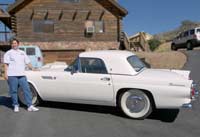












1955 Ford Thunderbird |
||
| Classic and Hot Rod Cars And Their Stories | ||
 Bonnie and her "T-Bird" |
||
| 1955 Ford Thunderbird | ||
Tom and Bonnie Green of Tehachapi acquired their "55 T-Bird" in September of 2001 in the little town of Orcutt, next to Santa Maria, CA. Tom had recently retired and had cash in hand to make a semi-foolish purchase. Up to this point Bonnie wasn't very impressed with old style cars, Tom felt this might change her mind, Bonnie has always liked the 55,56,57 series Thunderbirds. When we passed this one at a gas station with a "for sale" sign on it Tom turned in to take a look. After investigation I told the guy selling it "we'll take it! After driving it home I noticed it was smoking a little. In 2002 Tom pulled the engine, honed the cylinders, installed new rings, an oil pump, and had the heads reworked. Later, A new skirt replaced one that was mangled, and new molding for both sides were painted to match making a big difference in the look of the car. Since then we have kept it in the garage and bring it out for shows and cruise-ins.A Thunderbird is a mythological bird of power with supernatural strength and to the North American Indigenous people they represent ancestral spiritual guides. The thunderous bird stirs the wind as it flaps it's gigantic wings and causes the friction necessary to spark thunder and lightning. The 1955 Thunderbird from Ford was designed to compete against the Chevy Corvette and was also a 2 seater convertible coupe. The Ford Thunderbird began life in February 1953 in direct response to Chevrolet's new sports car, the Corvette, which was publicly unveiled in prototype form just a month before. Under rapid development, the Thunderbird went from idea to prototype in about a year, being unveiled to the public at the Detroit Auto Show on February 20, 1954. Like the Corvette, the Thunderbird had a two-seat coupe/convertible layout. Production of the Thunderbird began later on in 1954 on September 9 with the car beginning sales as a 1955 model on October 22, 1954. Though sharing some design characteristics with other Fords of the time, such as single, circular headlamps and tail lamps and modest tail fins, the Thunderbird was sleeker and more athletic in shape, and had features like a faux hood scoop and a 150 mph speedometer hinting a higher performance nature that other Fords didn't possess. Mechanically though, the Thunderbird could trace its roots to other mainstream Fords. The Thunderbird's 102.0 inches wheelbase frame was mostly a shortened version of that used in other Fords while the car's standard 292 cu in Y-block V8 came from Ford's Mercury division. Though inspired by, and positioned directly against, the Corvette, Ford billed the Thunderbird as a personal luxury car, putting a greater emphasis on the car's comfort and convenience features rather than its inherent sportiness. The Thunderbird sold exceptionally well in its first year. In fact, the Thunderbird outsold the Corvette by more than 23-to-one for 1955 with 16,155 Thunderbirds sold against 700 Corvettes. With the Thunderbird considered a success, few changes were made to the car for 1956. The most notable change was moving the spare tire to a continental-style rear bumper in order to make more storage room in the trunk. However, the addition of the weight at the rear caused steering issues, and was changed back in 1957. Among the few other changes were new paint colors, the addition of circular porthole windows in the fiberglass roof to improve rearward visibility, and a 312 cu in Y-block V8 making 215 horsepower when mated to a 3-speed manual transmission or 225 horsepower when mated to a Ford-O-Matic 3-speed automatic transmission. The Thunderbird was revised for 1957 with a reshaped front bumper, a larger grille and tail fins, and larger tail lamps. The 312 cu in V8 became the Thunderbird's standard engine, and now produced 245 horsepower Other, even more powerful versions of the 312 cu in V8 were available including one with two four-barrel Holley carburetors and another with a Paxton supercharger delivering 300 horsepower. Though Ford was pleased to see sales of the Thunderbird rise to a record-breaking 21,380 units for 1957, company executives felt the car could do even better, leading to a substantial redesign of the car for 1958. |
||
Note: All Images And Stories On This Site Are Copywrited. Use Of Any |
||
 Great Pricing & Selection of Cameras and Accessories: Top Camera Mall |
||
|
||

